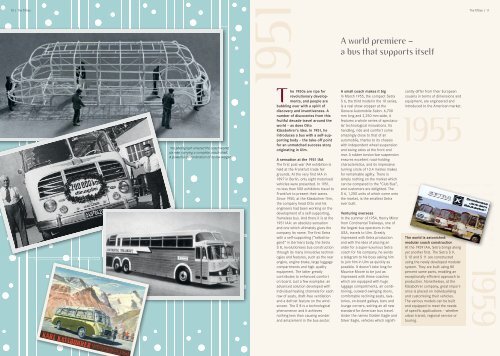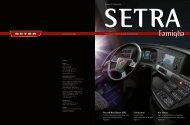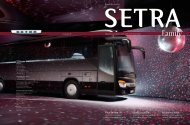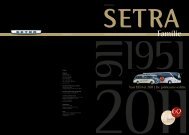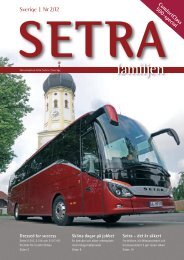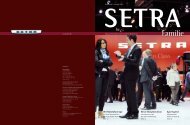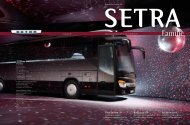Family - Setra
Family - Setra
Family - Setra
You also want an ePaper? Increase the reach of your titles
YUMPU automatically turns print PDFs into web optimized ePapers that Google loves.
This photograph amazed the coach world:<br />
six men carrying a complete coach shell.<br />
A powerful demonstration of its low weight.<br />
1951<br />
10 | The fifties The fifties | 11<br />
T<br />
he 1950s are ripe for<br />
revolutionary developments,<br />
and people are<br />
bubbling over with a spirit of<br />
discovery and inventiveness. A<br />
number of discoveries from this<br />
fruitful decade travel around the<br />
world – as does Otto<br />
Kässbohrer’s idea. In 1951, he<br />
introduces a bus with a self-supporting<br />
body – the take-off point<br />
for an unmatched success story<br />
originating in Ulm.<br />
A sensation at the 1951 IAA<br />
The first post-war IAA exhibition is<br />
held at the Frankfurt trade fair<br />
grounds. At the very first IAA in<br />
1897 in Berlin, only eight motorised<br />
vehicles were presented. In 1951,<br />
no less than 500 exhibitors travel to<br />
Frankfurt to present their wares.<br />
Since 1950, at the Kässbohrer firm,<br />
the company head Otto and his<br />
engineers had been working on the<br />
development of a self-supporting,<br />
frameless bus. And there it is at the<br />
1951 IAA: an absolute sensation<br />
and one which ultimately gives the<br />
company its name. The first <strong>Setra</strong><br />
with a self-supporting (“selbsttragend”<br />
in German) body, the <strong>Setra</strong><br />
S 8, revolutionises bus construction<br />
through its many innovative technologies<br />
and features, such as the rear<br />
engine, engine brake, large luggage<br />
compartments and high-quality<br />
equipment. The latter greatly<br />
contributes to enhanced comfort<br />
on board. Just a few examples: an<br />
advanced solution developed with<br />
individual heating channels for each<br />
row of seats, draft-free ventilation<br />
and a defrost feature on the windscreen.<br />
The S 8 is a technological<br />
phenomenon and it achieves<br />
nothing less than causing wonder<br />
and amazement in the bus sector.<br />
A world premiere –<br />
a bus that supports itself<br />
A small coach makes it big<br />
In March 1955, the compact <strong>Setra</strong><br />
S 6, the third model in the 10 series,<br />
is a real show-stopper at the<br />
Geneva Automobile Salon. 6,700<br />
mm long and 2,250 mm wide, it<br />
features a whole series of spectacular<br />
technological innovations. Its<br />
handling, ride and comfort come<br />
amazingly close to that of an<br />
automobile, thanks to its chassis<br />
with independent wheel suspension<br />
and swing axles at the front and<br />
rear. A rubber torsion-bar suspension<br />
ensures excellent road-holding<br />
characteristics, and its impressive<br />
turning circle of 13.4 metres makes<br />
for remarkable agility. There is<br />
simply nothing on the market which<br />
can be compared to the “Club Bus”,<br />
and customers are delighted. The<br />
S 6, 1,200 units of which come onto<br />
the market, is the smallest <strong>Setra</strong><br />
ever built.<br />
Venturing overseas<br />
In the summer of 1954, Henry Minor<br />
from Continental Trailways, one of<br />
the largest bus operators in the<br />
USA, travels to Ulm. Greatly<br />
impressed with <strong>Setra</strong> production<br />
and with the idea of placing an<br />
order for a super-luxurious <strong>Setra</strong><br />
coach for his company, he sends<br />
a telegram to his boss asking him<br />
to join him in Ulm as quickly as<br />
possible. It doesn’t take long for<br />
Maurice Moore to be just as<br />
impressed with these coaches<br />
which are equipped with huge<br />
luggage compartments, air conditioning,<br />
outward-swinging doors,<br />
comfortable reclining seats, lavatories,<br />
on-board galleys, bars and<br />
lounge corners, setting an all new<br />
standard for American bus travel.<br />
Under the names Golden Eagle and<br />
Silver Eagle, vehicles which significantly<br />
differ from their European<br />
cousins in terms of dimensions and<br />
equipment, are engineered and<br />
introduced to the American market.<br />
1955<br />
The world is astonished:<br />
modular coach construction<br />
At the 1959 IAA, <strong>Setra</strong> brings along<br />
yet another first. The <strong>Setra</strong> S 9,<br />
S 10 and S 11 are constructed<br />
using the newly developed modular<br />
system. They are built using 80<br />
percent same parts, enabling an<br />
exceptionally efficient approach to<br />
production. Nonetheless, at the<br />
Kässbohrer company, great importance<br />
is placed on individualising<br />
and customising their vehicles.<br />
The various models can be built<br />
and equipped to meet the needs<br />
of specific applications – whether<br />
urban transit, regional service or<br />
touring.<br />
1959


